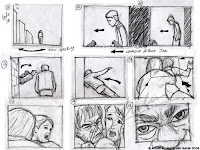Below: A slideshow which I made using picasa and then uploaded onto www.youtube.com
The slideshow contains images of my storyboard in which I designed in order to separate each scene therefore reducing confusion and also maximizing the chances that things will run smoothly when it comes to recording.
The second element of the Five S' is story boarding. Storyboards are graphic organisers such as a series of illustrations or images displayed in a sequence. Storyboards appear in many forms, from emerging literacy books to emergency instructions on airplaces to technical textbooks. When writers in various fields want to make ideas easily understood, they choose a storyboard format or one of its close cousins: the flow chart, the time line, or the PowerPoint presentation. Storyboards are widely used because we know pictures combined with text offer a rich synthesis of information that can entertain and inform. The pictures in picture writing can be simple cartoons, photographs, or sophisticated technical diagrams.


A storyboard can be any length, two or two thousand squares. A storyboard can be simple like the Cinderella board, or elaborate and dense in content like a graphic novel.
Storyboards also can be adapted to fit many tasks, from maps to time lines. Like making text lists down a page or writing text across the page, the way we arrange storyboard boxes can help convey the logic of the task at hand, and make that task easier to accomplish. To convey content, organization boxes can be arranged vertically or horizontally, or set in meaningful clusters.
No comments:
Post a Comment